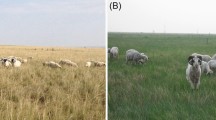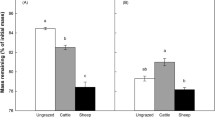Abstract
Herbivores influence nutrient cycling and primary production in terrestrial plant communities. However, both empirical and theoretical studies have indicated that the mechanisms by which herbivores influence nutrient availability, and thus their net effects on primary production, might differ between time scales. For a grassland in southeast England, we show that the effects of rabbits on primary production change over time in a set of grazed plots paired with exclosures ranging from 0 to 14 years in age. Herbivore exclusion decreased net aboveground primary production (APP) in the short term, but increased APP in the long term. APP was closely correlated with N mineralization rates in both grazed and ungrazed treatments, and accumulation of litter within the grazing exclosures led to higher N mineralization rates in exclosures in the long run. Rabbit grazing did not influence litter quality. The low contrast in palatability between species and the presence of grazing-tolerant plants might prevent rabbits from favoring unpalatable plant species that decompose slowly, in contrast to results from other ecosystems. Our results indicate that it is essential to understand the effects on N cycling in order to predict the effect of rabbit grazing on APP. Rabbits might decrease N mineralization and APP in the long term by increasing losses of N from grasslands.




Similar content being viewed by others
References
Aerts R, Chapin FS (2000) The mineral nutrition of wild plants revisited: a re-evaluation of processes and patterns. Adv Ecol Res 30:1–67
Augustine DJ, Frank DA (2001) Effects of migratory ungulates on spatial heterogeneity of soil nitrogen properties on a grassland ecosystem. Ecology 82:3149–3162
Bardgett RD, Wardle DA (2003) Herbivore-mediated linkages between aboveground and belowground communities. Ecology 84:2258–2268
Bazely DR, Jefferies RL (1989) Lesser snow geese and the nitrogen economy of a grazed salt marsh. J Ecol 77:24–34
Belovsky GE, Slade JB (2000) Insect herbivores accelerate nutrient cycling and increases plant production. Proc Natl Acad Sci USA 97:14412–14417
Cingolani AN, Posse G, Collantes MB (2005) Plant functional traits, herbivore selectivity and response to sheep grazing in Patagonian steppe grasslands. J Appl Ecol 42:50–59
Cornelissen JHC (1996) An experimental comparison of leaf decomposition rates in a wide range of temperate plant species and types. J Ecol 84:589–598
Crawley MJ (1983) Herbivory: the dynamics of plant herbivore interactions. Blackwell Scientific, Oxford
Crawley MJ (1990) Rabbit grazing, plant competition and seedling recruitment in acid grasslands. J Appl Ecol 27:803–820
Crawley MJ (2005) The flora of Berkshire. Brambleby Books, Harpenden
Del-Val E, Crawley MJ (2005) Are grazing increaser species better tolerators than decreasers? An experimental assessment of defoliation tolerance in eight British grassland species. J Ecol 93:1005–1016
Dias A (1998) Comparison of methods for measuring rabbit incidence on grasslands. Mammalia 62:205–212
de Mazancourt C, Loreau M, Abbadie L (1998) Grazing optimization and nutrient cycling: when do herbivores enhance plant production? Ecology 79:2242–2252
de Mazancourt C, Loreau M, Abbadie L (1999) Grazing optimization and nutrient cycling: potential impact of large herbivores in a savanna ecosystem. Ecol Appl 9:784–797
de Mazancourt C, Loreau M (2000) Effect of herbivory and plant species replacement on primary production. Am Nat 155:735–754
Frank DA, Evans RD (1997) Effects of native grazers on grassland N cycling in Yellowstone National Park. Ecology 78:2238–2248
Frank DA, Groffman PM (1998) Ungulate vs landscape control over C and N processes in grasslands of Yellowstone National Park. Ecology 79:2229–2241
Frank DA, McNaughton SJ (1993) Evidence for the promotion of aboveground grassland production by native large herbivores in Yellowstone National Park. Oecologia 96:157–161
Frank DA, Groffman PM, Evans RD, Tracy BF (2000) Ungulate stimulation of nitrogen cycling and retention in Yellowstone Park grasslands. Oecologica 123:116–121
Frank DA, Kuns MM, Guido DR (2002) Consumer control of grassland plant production. Ecology 83:602–606
Frank DA, Evans RD, Tracy BE (2004) The role of ammonia volatilization in controlling the natural N-15 abundance of a grazed grassland. Biogeochemistry 68:169–178
Grime JP (1996) Evidence of a causal connection between anti-herbivore defence and the decomposition rate of leaves. Oikos 77:489–494
Krebs CJ (1989) Ecological methodology. Harper Collins, New York
Lauenroth WK (2000) Methods of estimating belowground net primary production. In: Sala OE, Jackson RB, Mooney HA, Howarth RW (eds) Methods in ecosystem science. Springer, Berlin Heidelberg New York, pp 58–71
McNaughton SJ, Milchunas DG, Frank DG (1996) How can net primary productivity be measured in grazing ecosystems? Ecology 77:974–977
McNaughton SJ, Banyikwa FF, McNaughton MM (1997) Promotion of the cycling of diet-enhancing nutrients by African grazers. Science 278:1798–1800
Milchunas DG, Laurenroth WK (1993) Quantitative effects of grazing on vegetation and soils over a global range of environments. Ecol Monogr 63:327–366
Molvar EM, Bowyer RT, van Ballenberghe V (1993) Moose herbivory, browse quality, and nutrient cycling in an Alaskan treeline community. Oecologia 94:472–479
Oesterheld M, McNaughton SJ (2000) Herbivory in terrestrial ecosystems. In: Sala OE, Jackson RB, Mooney HA, Howarth RW (eds) Methods in ecosystem science. Springer, Berlin Heidelberg New York, pp 151–158
Olofsson J, Oksanen L (2002) Role of litter decomposition for the increased primary production in areas heavily grazed by reindeer, a litterbag experiment. Oikos 96:507–515
Olofsson J, Stark S, Oksanen L (2004) Herbivore influence on ecosystem processes in the tundra. Oikos 105:386–396
Pastor J, Naiman RJ (1992) Selective foraging and ecosystem processes in boreal forests. Am Nat 131:690–705
Pastor J, Dewey B, Naiman RJ, McInnes PF, Cohen Y (1993) Moose browsing and soil fertility in the boreal forests of Isle Royale National Park. Ecology 74:467–480
R development Core Team (2005) R: a language and environment for statistical computing. R foundation for statistical computing, Vienna, Austria. ISBN 3–900051–07–0, http://www.R-project.org
Raison RJ, Connell MJ, Khanna PK (1987) Methodology for studying fluxes of soil mineral-N in situ. Soil Biol Biochem 19:521–530
Ritchie ME, Tilman DJ, Knops MH (1998) Herbivore effects on plant and nitrogen dynamics in oak savanna. Ecology 79:165–177
Robinson M, Dean TJ (1993) Measurement of near surface soil water content using a capacity probe. Hydrol Proc 7:77–86
Ruess RW, McNaughton SJ (1987) Grazing and the dynamics of nutrients and energy regulated microbial processes in the Serengeti grasslands. Oikos 49:101–110
Ruess HW, Hik DS, Jefferies RL (1989) The role of lesser snow geese as nitrogen processors in a sub-arctic marsh. Oecologia 79:23–29
Sala OE, Austin AT (2000) Methods of estimating aboveground net primary productivity. In: Sala OE, Jackson RB, Mooney HA, Howarth RW (eds) Methods in ecosystem science. Springer, Berlin Heidelberg New York, pp 33–41
Schimel DS, Parton WJ, Adamsen FJ, Woodmansee RG, Senft RI, Stillwell MA (1986) The role of cattle in the volatile loss of nitrogen from a shortgrass steppe. Biogeochemistry 2:39–52
Sirotnak JM, Huntly NJ (2000) Direct and indirect effects of herbivores on nitrogen dynamics: voles in riparian areas. Ecology 81:78–87
Schlesinger WH, Raikes JA, Hartley AE, Cross AF (1996) On the spatial distribution of soil nutrients in desert ecosystems. Ecology 77:364–374
Stark S, Grellmann D (2002) Soil microbial responses to herbivory in an arctic tundra heath at two levels of nutrient availability. Ecology 83:2736–2744
Tilman DA (1988) Plant strategies and the dynamics and structure of plant communities. Princeton University Press, Princeton
Van der Wal R, Bardgett RD, Harrison HA, Stien A (2004) Vertebrate herbivores and ecosystem control: cascading effects on tundra ecosystems. Ecography 27:242–252
Van Winjen HJ, Van der Wal R, Bakker JP (1999) The impact of herbivores on nitrogen mineralization rate: consequences for salt-mash succession. Oecologia 118:225–231
Vitousek PM, Howarth RW (1991) Nitrogen limitation on land and in the sea: how can it occur? Biogeochemistry 13:87–115
Wardle DA (2002) Communities and ecosystems: linking the aboveground and belowground components. Princeton University Press, Princeton
Willot SJ, Miller AJ, Incoll LD, Compton SG (2000) The contribution of rabbits (Oryctolagus cuniculus L.) to soil fertility in semi-arid Spain. Biol Fertil Soils 31:379–38
Acknowledgments
The work was founded by The Swedish Research Council for Environment, Agricultural Sciences and Spatial Planning and from the Swedish Foundation for International Cooperation in Research and Higher Education. The rabbit exclosures are part of a network of long-term field studies in Silwood Park supported by the Department of Biological Sciences, Imperial College London.
Author information
Authors and Affiliations
Corresponding author
Additional information
Communicated by Malcolm Press.
Rights and permissions
About this article
Cite this article
Olofsson, J., de Mazancourt, C. & Crawley, M.J. Contrasting effects of rabbit exclusion on nutrient availability and primary production in grasslands at different time scales. Oecologia 150, 582–589 (2007). https://doi.org/10.1007/s00442-006-0555-4
Received:
Accepted:
Published:
Issue Date:
DOI: https://doi.org/10.1007/s00442-006-0555-4




